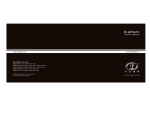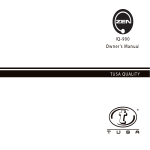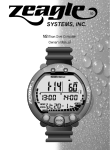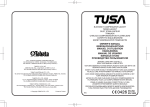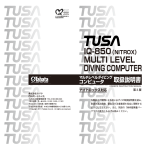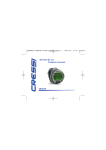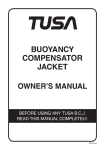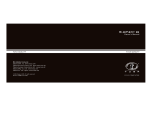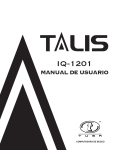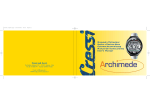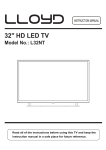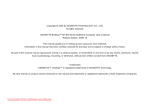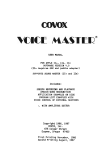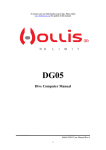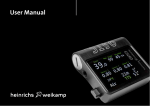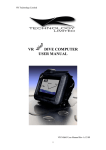Download IQ-850 DC Sapience II Computer
Transcript
II IQ-850 DIVE COMPUTER OPERATING MANUAL User Manual Contents IQ-850 Flow Chart and Information 1. Introduction 2. Key Features 3. Common Sense Warnings 4. Accessing Display Modes 5. Time Mode 6. Dive Set Mode 7. Dive Plan Mode 8. Log Profile Mode/Warnings 9. History Mode 10. PC Transfer Mode 11. Time Set Mode 12. Dive Mode 13. Warning Screens 14. Altitude Setting 15. Battery Level Icon 16. Battery Replacement 17. Units of Measurement 18. General Handling 19. Warranty 22. Technical Specifications 1 2 8 8 8 11 12 14 16 18 23 24 25 26 31 36 38 38 39 39 40 44 IQ-850 Flow Chart 2 IQ-850 Flow Chart cont. 3 IQ-850 Flow Chart cont. 4 IQ-850 Flow Chart cont. 5 IQ-850 Flow Chart cont. 6 IQ-850 Flow Chart cont. 7 1. Introduction Congratulations on your choice of the TUSA IQ-850 Dive Computer. The IQ-850 is a compact and sophisticated dive instrument that will give you reliable, trouble free performance, dive after dive. The information in this manual has been developed for your safety. Please read and understand this manual completely before using your new TUSA dive computer. 2. Key Features Among the IQ-850’s key features: • • • • • • • • • Air, Nitrox, Gauge and Time Operating modes Dot matrix tissue compartment/message display window Vibration, audible, and visual alarms 2 mix switching feature: Mix 1(Air, 21-99%), Mix 2(21-99%) 25 hour/dive log memory, PC downloadable Advanced user safety settings and alarms Manual or Water activation Large alphanumeric and backlit display User replaceable battery (Battery: CR2032) 3. Common Sense Warnings As is true of every piece of diving equipment, including all dive computers, the IQ-850’s abilities are not limitless. There are certain limitations and restrictions of which you must be aware, and certain precautions you must take when using the IQ-850. 8 WARNINGS Before using the IQ-850, it is extremely important you read the following points as well as similar warning and caution notices that appear throughout this manual. Failure to do so could result in damage to or loss of equipment, serious personal injury, or death. The IQ-850 is designed for use by certified, recreational divers who have maintained a sufficient level of knowledge and skill proficiency through a combination of formal training, ongoing study and experience. It is not intended for use by persons who lack the qualifications, and thus may not be able to identify, assess, and manage the risks scuba diving entails. Use of the IQ-850 in conjunction with Enriched Air Nitrox (EANx) further requires that the diver be trained and certified for Nitrox diving. The IQ-850 is not intended for use by commercial, military or technical divers whose activities may take them beyond the commonly accepted depth limits for recreational diving. The IQ-850 is designed for use by divers breathing either normal compressed air or Enriched Air Nitrox (EANx) mixtures whose fraction of Oxygen falls within a range of 22 to 99 percent. Although the IQ-850 is capable of calculating decompression stop requirements, this ability is provided as a safety feature only, should a diver accidentally exceed the No-Decompression Limits (NDLs). Dives requiring mandatory stage decompression carry substantially greater risk than dives made well within no-decompression limits. Decompression diving is widely believed to entail substantially greater risk of decompression illness than dives made well within the No-Decompression Limits (NDL). The IQ-850 provides decompression stop information solely as a contingency in case divers accidentally exceed the No-Decompression Limits. It is not designed or intended for use as a tool to plan or execute dives that participants know will entail mandatory decompression. 9 WARNINGS The IQ-850 is designed to be used by only one diver at a time. Divers should not share a single IQ-850, or any dive computer, on the same dive. Additionally, no diver should lend his or her IQ-850 to anyone else until it calculates that no measurable residual nitrogen remains after previous dives, and displays neither the “Desaturation Time” nor “No Fly” indicators while in Surface Mode. Further, no diver should use his or her IQ-850 for repetitive dives unless that same IQ-850 has accompanied him or her on all previous dives in the same repetitive dive series. Neither the IQ-850, nor any other dive computer presently available, physically measures the amount of nitrogen present in body tissues, or the rate at which this nitrogen is being absorbed or released. Instead, the IQ-850 monitors depth and time, and uses this data to work a mathematical formula designed to emulate how individuals in good general health and whose physical characteristics do not place them among those at higher risk of decompression illness are assumed to absorb and release nitrogen from body tissues. Thus, the IQ-850 cannot compensate for factors such as age, obesity, dehydration, cold or exertion, which experts believe place divers at greater risk of DCI. If these, or similar factors apply to you, use the IQ-850, and any other dive computer or dive table, with even greater caution. Experts still know surprisingly little regarding the exact nature and causes of decompression illness (also known as decompression sickness, DCI, or DCS). Susceptibility to DCI may vary substantially from person to person and from day to day. Neither the IQ-850, nor any dive computer or table, can guarantee that you will not suffer decompression illness. Even though you use these items correctly, you may still suffer DCI. Do not rely on the IQ-850 as your sole means of avoiding decompression sickness. 10 Experts recommend divers wait at least 24 hours following any dive before flying in an aircraft or driving to altitude. Failure to allow sufficient surface interval before doing so may substantially increase the risk of Decompression Illness (DCI). Do not plan dives to depths deeper than those for which the IQ-850 is capable of displaying an available No-Decompression Limit. Doing so could cause you to exceed the No-Decompression Limits or limiting PO2 of 1.6 bar, which may in turn substantially increase your risk of decompression illness or CNS Oxygen Toxicity and can lead to serious personal injury or death. 4. Accessing Display Modes B E A C Figure 1 There are some display modes that the IQ-850 enters and/or exits automatically. For example, by taking the IQ-850 underwater, you automatically activate its Dive Mode. Upon surfacing your IQ-850 will automatically enter Time Mode. To access other modes, you may need to push one of the three large buttons on the sides of the IQ-850. These are the A, B, and C buttons. (Fig. 1) You will find these buttons easy to use. In some instances, you may need to press a button once and release it to achieve the desired result. In other instances, you may need to hold the button down until you get the result you wish. This manual will outline which procedure to follow for each mode or task. Throughout this manual display icons that blink are shown surrounded by gray bars. 11 5. Time Mode Time mode is the IQ-850’s default mode. In this mode the screen displays a minimum of the current date and time of day. Within 24 hours of surfacing from a dive, the IQ-850 will display additional information while in Time Mode. A description of the screens is shown below. (Fig. 2,3) PGT Display Graph Normal Mode Figure 2 • • • • • • • • Post Dive Mode Figure 3 Current time: This is the current time of day. Current date: This is the current date. Current weekday: This is the current day of the week. Battery indicator Icon: This displays low battery voltage. (not shown unless necessary) PGT (Pressure Gas in Tissue) graph: Indicates the level of Nitrogen in the twelve tissue compartments. The higher the bar displayed the greater the nitrogen level in the tissue. +/- denotes off or on-gassing. OLI (Oxygen Limited Indicator) graph: This indicates the level of Oxygen in the diver's body with eight level indicators. Nitrox Icon: This Icon is ON when NITROX has been selected. Desaturation time (DESAT): This indicates the time remaining until the body’s internal nitrogen is desaturated. The DESAT is also displayed if PGT occurs because of a change in the altitude rank. 12 • Surface time (SURF.T): This is the surface interval time after a dive. The timer is started from when the depth shown in Dive mode reaches 5 feet (1.4m) or less. If the depth changes back to 5 feet (1.4m) or more in less than 10 minutes, the previous dive is continued. Surface time is continued for 48 hours. After that, surface time is turned off. • Mode: This display shows the computer in Time mode. • Don’t Fly "Airplane" Icon: While the desaturation time is calculated this icon is displayed during Time Mode. When the computer has finished calculating desaturation time this Icon is turned off. Warning Experts recommend divers wait at least 24 hours following any dive before flying in an aircraft or driving to altitude. Failure to allow sufficient surface interval before doing so may substantially increase the risk of Decompression Illness (DCI). Operation of buttons during Time mode Prior to a dive The letters correspond to the buttons of the IQ-850 shown in Figure 1. • A button: Press this button to scroll to next mode. • A button held for 2-3 seconds: Reverts to time mode. • B button held down: Time display and backlight comes on. • C button: Activates backlight. • B+C button: Activates alarm sound or vibration test. • E button: Touch this switch and metal housing to switch to dive mode. During a surface interval • • • • • A button: Press this button to scroll to next mode. B button: Time display and backlight comes on. C button: Activates backlight. B+C button: Activates the alarm sound or vibration test E button: Touch this button and the metal housing to switch to dive mode. 13 6. Dive Set Mode To enter Dive Set mode from Time mode, press the A button 2 times until "DIVESET" is shown at the top of the display. Note: If the surface interval is less than 10 minutes the computer will not enter this mode. The computer will switch to dive plan mode. Dive Set Mode Nitrox Icon Altitude Icon PO2 Maximum Depth FO 2 User Safety Factor Max PO2 Figure 4 Use the dive set mode to set the (FO2) MIX1/MIX2 %, user safety factor (SF-1/2), depth/dive time alarms and on/off, warning alarm (VIBE/SOUND), DIVE/Gauge mode, and seawater or freshwater (Sea/Fresh) settings. (Fig. 4) • FO2 (fraction of oxygen): This displays the oxygen concentration that is currently selected. If the FO2 is set at 21%, "Air" is displayed, if 22-99% "Nitrox" is displayed. • PO2 Maximum depth: This displays the PO2 maximum depth (when PO2=1.4) appropriate for the displayed FO2 • SF (Safety Factor): This displays the SF value set by the diver. The larger the value, the greater the safety level (SF-0, 1 or 2). • Alarm operations: The graph will display VIBE, or SOUND. • Nitrox Icon: This Icon is ON when NITROX has been selected. • Sea/Fresh Icon: This shows whether the computer has been set to fresh or salt water for depth calculations. • Mode: Displays “DIVESET” when in dive set mode. 14 Operation of buttons during Dive Set mode. • Β: Press the B button to enter/select the function you would like to modify. • C: Use this button to change the value of the selection. If held down during the FO2 selection the value will scroll rapidly in one percent increments. The selected alarm will sound/vibrate for 1 second when changing the warning setting. The alarm test will not be performed if the battery is low. • E: Touch this button and the metal housing to switch to dive mode. The computer will enter time mode once the E button is released. If no buttons are pushed for 2 to 3 minutes, the computer will return to TIME mode. Dive Set Flowchart 15 7. Dive Plan Mode To enter Dive plan mode from Time mode, press the A button three times until the "DIVEPLAN" screen is shown. Note: This mode cannot be entered if the computer is in an out of measurement range lock or a decompression stop violation lock. In both instances the computer will skip to the dive log mode. Please note: altitude measurements are not performed in dive plan mode. By setting the depth and surface time, the no decompression limit (NDL) for that depth can be calculated. (Fig. 5,6) The following information is displayed during this mode: Surface Time: This displays the time currently elapsed since surfacing and the total surface time needed to return to the selected depth. Depth: This displays the desired depth. NDL: The no decompression limit for the selected depth, based on surface time, is displayed. The maximum NDL that can be displayed is 200 minutes. If the selected depth will result in a PO2 greater than 1.4, the display will show bar. N2: This will display the PGT (pressure gas in tissue) of nitrogen absorbed in the diver’s body at the set surface time (Fig. 6). O2: This will indicate the level of oxygen in the body during the set surface time. Nitrox icon: This icon will be on when the FO2 is set at 22 percent or higher. Please note: Figure 5 and 6 displays will scroll every 2 seconds to give the user the ability to view PGT tissue compartment loading data. 16 Depth Display Mode NDL (no decompression limit time) Depth Setting (m) Figure 5 NDL (no decompression limit time) PGT Display Mode Figure 6 Operation of buttons during dive plan mode • A: Use this button to move to dive plan mode. If the button is held down for 2 to 3 seconds the computer will return to time mode. • B: Press this button to increase and select a desired depth setting. If the button is held in, the value will scroll rapidly. • C: Press this button to decrease and select a desired depth setting. If this button is held in, the value will scroll rapidly. • Ε: When water is detected the computer moves to dive mode. • Auto return: The display automatically returns to time mode when no buttons are used for 2-3 minutes. 17 8. Log Profile Mode To enter Log Profile mode from Time mode, press the A button five times until "LOG PROFILE” is shown. Description of the Log Profile functions The log profile mode records various data during a dive when the dive depth is at least 5 feet (1.5m) and the dive time is at least 3 minutes. Data is recorded during each successive dive, and the log data storage capacity is about 25 hours of dive time, or up to 25 log data entries (30 sec sampling rate). If the logged dive time exceeds 25 hours or the number of log data entries exceeds 25, the oldest data is automatically deleted. The logged data is described below. (Fig. 7,8,9) • Log number: This indicates the number of the log entry being recorded among the recorded logs. • Dive date/Dive start time/ Dive end time: This is diving information. Dive date is the date of the dive. Dive start time is the time at the start of the dive. Dive end time is the time at the end of the dive. Both Dive start time and Dive end time are displayed in 24 hour format. • PGT graph: This displays the level of Nitrogen in each of the 12 tissue compartments at the end of the dive. • OLI (Oxygen Limited Indicator) graph: This represents the level of the Oxygen Limit with eight level indicators at the end of the dive. • Altitude rank: This is the altitude setting used during the dive. • Nitrox icon: This Icon is ON when NITROX has been used for the dive • Fraction of oxygen (FO2): It displays the FO2 which was used while diving. • Dive time: This is the dive time. • Water temperature: Water temperature at maximum depth. The measurement range is: 23-104°F (-5.0 to 40.0℃). It displays ‘Lo’ when water temperature is under 23°F (-5℃). It displays ‘Hi’ when water temperature is over 104°F (40.0℃). • Safety Factor (SF): When the level is "0" the usual algorithm is used for calculations. When the level is "1" or "2" the next higher altitude rank is used for the dive calculations. The default setting is "0". 18 • Average depth: This is the average water depth during the dive. If the depth is over 328 ft (99.9m), the display is ‘---’. • Maximum depth: This is the maximum depth recorded during a dive. If the depth is over 328 ft (99m) the display is ‘---’. • Ascent rate indicator: This is the maximum ascent rate recorded during a dive. • Sea/Fresh icon: This indicates the water setting (sea water/fresh water). Dive date Display 1 Dive number Maximum depth Figure 7 Dive start Ascent rate indicator Display 2 Log number PGT Tissue Graph Dive time Average depth Fraction of oxygen Dive end Figure 8 Safety Factor Water Temp. No data Display Figure 9 19 Warning Displays: These are warnings that can occur during a dive. For further description of these warnings see the "dive mode" section. Alarm Displays Ιf the following warnings occur during dive mode they are stored in memory and displayed. Ascent rate warning: If the ascent rate warning is activated it is recorded in the log. The SLOW icon will blink when the dive log is displayed. (Fig. 10) SLOW icon blinks Figure 10 Decompression stop violation: If a deco stop is violated, the warning is stored in memory and the DECO icon blinks when the log is displayed. (Fig. 11) Deco Icon Blinks Figure 11 20 PO2 warning: The PO2 icon blinks if the warning was active during the dive. (Fig. 12) PO2 Icon Blinks Figure 12 OLI warning: If the OLI reaches 8 bars, the warning is stored in memory and displayed in log mode. (Fig. 13) OLI Bar Icon Blinks Figure 13 Decompression dive warning: If the dive enters decompression, then the warning is stored and displayed during log mode. (Fig. 14) Deco Icon Figure 14 21 Out of Measurement Range warning: If the computer entered out of range during the dive, then the event is recorded in memory and the entire display will blink during the log mode. (Fig. 15) All Segments Blink Figure 15 Operation of buttons during Log mode • Α: Press once to move to PC Transfer. Press and hold this button for 2-3 seconds to move to time mode. • Β: Press this button to change log number. (25-1→25-2→25-3→1-1→1-2→1-3---→24-1→24-2) • Β: Press and hold this button to increase log number using fast scrolling. • C: Press this button to change the log number. (1-3→1-2→1-1→2-3→2-2→2-1→------→25-3→25-2→25-1) • C: Press and hold this button to decrease log number using fast scrolling. • Ε: When water is detected, the mode moves to dive mode. • Auto return: The display automatically returns to time mode when no buttons are used for 2-3 minutes. 22 9. History Mode The IQ-850 records the total number of dives, maximum depth, and total accumulated dive time for Dive and Gauge modes in HISTORY. (Fig. 16,17) To enter HISTORY mode from Time mode, press the A button four times until the display reads “HISTORY”. To clear the dive history, press and hold the B+C buttons for 5 to 6 seconds. Then select Max, Time or # and press C button for 3 seconds to clear the respective field. A confirmation will occur once the history is reset. Maximum Water Depth Total Dive Time (hrs) Total Dive Time (min) Figure 16 History Mode Total Number of Dives No Data Bars are shown and blink Figure 17 23 1. PC Transfer Mode To enter PC transfer mode (data download requires USB cable part# IQ-800PC), press the A button six times from TIME mode. If surface time is less than 10 minutes after a dive, and there is no log and profile data, the computer will move to Time mode. (Fig 19,20) Normal No Data Figure 19 Figure 20 Description of display during PC transfer mode • Battery indicator Icon: This displays the current battery voltage. • Mode display: This shows PC transfer mode. Operation of buttons • Α: Press this button to move to time set mode. • Β: No function • C: No function • Ε: No function • Τhe transfer mode remains active for 14-15 minutes and then moves to time mode. • Α: Press and hold this button for 1-2 seconds to move to time mode. The computer switches to time mode when the transmission ends. Please consult the installation and user instructions with the IQ-800PC cable and software for further information. 24 1. Time Set Mode From TIME mode press the A button seven times until "TIMESET" is displayed, the lower right seconds indicator will flash. Note: If surface interval time is less than 10 minutes after a dive, the computer will not enter this mode. (Fig. 21) Description of displayV during Time 6et 0ode • Current time: This is the current time of day. • AM/PM Icon: This icon is shown in 12 hour format. • Current date: This shows the current year, month, and day. • Battery indicator Icon: This displays the current battery voltage. • Segment All On/Contrast: This allows display contrast adjustment. Current Time Segment All On Current Year Contrast Figure 21 Operation of buttons during Time set mode Α: Press button to select mode. Β: Press this button to select the value to change. C: Press this button to change the value. C: Press and hold this button to change setting the value using fast scrolling. • Ε: When water is detected the mode moves to dive mode. • Auto return: The display automatically returns to Time mode when no buttons are used for 2 to 3 minutes. • A: Press and hold this button for 1-2 seconds to move to Time mode. •..B+C: Press and hold both buttons for 2-3 seconds and depress B 1 time to change screen contrast and view software version. • • • • 25 12. Dive Mode The IQ-850 will automatically enter dive mode when the E buttons come in contact with water. Description of functions during dive mode The are several different displays and functions available in DIVE mode including: non-decompression dive mode, decompression dive mode, safety stop time, gauge and out of measurement range condition. The functions of each mode are described below. Non-decompression mode This is for a non-decompression (NDL) dive. (Fig. 22) PGT graph Current Depth Dive Time FO2 PO2 NDL Figure 22 Decompression mode This is used for dives that last longer than the NDL’s. The DECO icon warning will continue until the advised depths are reached. If you ignore the DECO warning and go straight to the surface for longer than 10 minutes, the display will freeze and all calculations will stop. The IQ-850 will switch automatically to TIME mode after 48 hours have elapsed. This information is recorded in the dive log. The IQ-850 can only switch to log, profile, or PC transfer mode while the calculations have stopped. (Fig. 23) 26 Decompression Dive Stop Depth Stop Time Total ascent To access screen 2 hold B button Figure 23 Safety Stop Timer This timer shows the recommended safety stop time while in dive mode. If the diver descends over 32 feet (9.9m), then comes up to a depth of 20 feet (6m), this value appears instead of NDL. Safety stop time starts at 3 minutes and is counted down until the time is 0. The safety stop timer disappears and NDL appears in its place once the timer reaches zero. The timer stops temporarily if the depth becomes equal to or more than 26.5 feet (8.1m) during which time the counter stops temporarily, and the NDL display appears again. The timer is reset if the depth becomes equal to or more than 33 feet (10 m). (Fig. 24) If the diver doesn’t follow the safety stop information, the IQ-80 doesn’t impose any penalty. Safety Stop Safety Stop Timer NDL 27 PO2 To access screen 2 hold B button Figure 24 Out of measurement range condition When exceeding a measurement range, the exceeded parameter becomes '---' display and all of the displays blink. The following situations will cause an Out of Measurement Range condition. Case 1: The water depth exceeds 328 ft(99.9m). Case 2: The dive time exceeds 599 minutes. Case 3: Decompression is required at a decompression stop depth greater than 30 meters (100 feet) . Case 4: Decompression stop time has exceeded 99 minutes Case 5: Total ascent time has exceeded 99 minutes Figure 25 During an Out of Measurement condition the entire display blinks. Display description during Dive mode • N'/1R'HFRPSUHVVLRQ/LPLW: This is the diving time possible for a non-decompression dive at current depth. • &XUUHQWGHSWK: This indicates the current water depth. The water depth is measured every 1 second. • Dive time: This is the current dive time. It will end at a depth of 5ft or less. The maximum dive time displayed is 599 minutes. • Pressure of Oxygen (PO2): This indicates the PO2 value at the current depth. This value is calculated upon fraction of oxygen and current depth. • N2 (Pressure Gas in Tissue - Nitrogen) graph: This indicates the level of nitrogen absorption in the tissue, measured in 12 compartments. • O2 (Oxygen Limited Indicator) graph: This indicates the level of Oxygen currently in the diver's body. 28 • Nitrox Icon: This Icon is on when NITROX has been set at 22% or higher • Ascent rate bar graph: The greater number of indicators displayed, the greater the ascent rate. • Ascent rate warning: The SLOW icon and "SLOW" warning are displayed if the ascent rate is 7 or higher. • Fresh/Sea icon: Indicates whether the computer is set to fresh or salt water • PO2 Warning: If the PO2 is 1.4 or above a warning is displayed. If the PO2 reaches 1.6 or above the whole OLI bar graph will also blink • OLI Warning: If the OLI is showing 7 indicators or higher the OLI bar graph blinks and the "OLI" warning is displayed. • Altitude level: Displays the current altitude rank being used. • Decompression stop depth (Ceiling): The decompression stop depths are calculated according to the dive conditions and then displayed (10-320 ft/3-99m) • Decompression stop time (DECO STOP TIME): This is the amount of time to be spent at a decompression stop depth. A countdown timer is shown during decompression. • Total ascent time(TOTAL): This indicates the total amount of time required for ascent from the current depth to the surface, assuming that all decompression stops are made. • DECO icon: This icon appears if the diver must perform decompression prior to surfacing. • Fraction of oxygen (FO2): This icon displays the FO2 which was set for the dive. WARNING Do not use your IQ-850 without confirming that its FO2 setting accurately matches that of your breathing media. Failure to do so may mean that your IQ-850 will be unable to accurately monitor your exposure to nitrogen and oxygen, and lead to decompression illness (DCI) or CNS Oxygen Toxicity, conditions that can cause serious person injury or death. 29 • Decompression dive warning: When the NDL is exceeded and the IQ-850 changes to Decompression mode, the word DECO is displayed. This information is recorded in the dive log. • Decompression stop violation warning: if a depth shallower than the decompression stop depth is recorded, the DECO icon blinks and the "DECO" warning is displayed as a decompression stop violation warning. • Mode: the mode will display "DECO". Operation of buttons during Dive mode Non-decompression (Fig. 26) • A: Turns the back light on from 4-5 seconds. • Β: When user pushes and holds button B, it displays secondary display, showing the temperature, the dive time, the maximum water depth, the setting FO2 value and back light is on from 4-5 seconds. • C: Turns the back light on from 4-5 seconds. Ιn less than 5 feet (1.5 m) of water the IQ-850 moves to time mode. Decompression • A: The back light is on from 4-5 seconds. • Β: When user pushes and holds a button B, it displays the temperature, the dive time, the maximum water depth, the setting FO2 value, and the back light is on from 4-5 seconds. • C: Back light is on from 4-5 seconds. Once the diver is less than a depth of 5 ft and after 10 minutes the IQ-850 moves to Decompression stop violation lock if a violation occurred during the dive. The computer can’t be used for 48 hours. The mode will be automatically switched to time mode after 48 hours have elapsed. 30 Warning Screens The following warning screens may appear during a dive. If a warning appears the diver should take immediate action to correct the warning. Ascent Rate warning: If the ascent rate is exceeded, the SLOW icon, current depth, ascent rate bar graph, and SLOW mode icon will blink. If it is activated again within with 6 seconds, the warning will be recorded in the log. The ascent rate bar graph will show up to 10 indicators. (Fig. 26) Figure 26 NDL warning: If the NDL decreases to less than 3 minutes, the diver is alerted by the NDL icon and the NDL time blinking for 6 seconds. The sound or warning vibration will operate for three seconds. (Fig. 27) Figure 27 31 • Decompression stop violation warning: When current depth is shallower than the indicated decompression stop depth, the IQ-850 will alert the diver with the display and the alarm. If the diver returns to the indicated water depth, the warning display stops blinking. This information is recorded in the dive log. (Fig. 28) Decompression stop violation warning The DECO information and the DECO icon will blink continuously. The warning will operate twice for three seconds. Figure 28 • PO2 warning: The PO2 warning has two levels. (Fig. 29) a. PO2 equals 1.4 or 1.5: The current depth, PO2 icon, PO2 value, and PO2 indicator blinks for 15 seconds. b. PO2 equals 1.6 or more: The current depth, PO2 icon, PO2 indicator, and OLI bar graph (8 indictors) blinks continuously. In both cases the sound or vibration warning will operate twice for three seconds each time. PO2 warning Figure 29 32 • Oxygen Limit Indicator warning: When the OLI graph reaches 7 or 8 bars, the IQ-850 responds with a flashing display and the alarm. There are two types of warnings, as described below. (Fig. 30) a. 7 bars displayed: The OLI bar graph will blink for 15 seconds. b. 8 bars displayed: The OLI bar graph will blink continuously. This information is recorded in the dive log. The warning sound or vibration will operate twice for three seconds each time the warning is active. OLI warning Figure 30 Decompression dive warning: If the NDL is 0 and a decompression dive is entered, the diver is alerted with a warning, followed by the decompression information display. Once the dive becomes a deco dive the PGT bar graph, DECO icon, and “DECO” indicator blink for 15 seconds. The sound or vibrating alarm will operate twice for three seconds. The information is recorded in the log. (Fig. 31) Figure 31 33 Out of Measurement range warning: If the computer enters this warning mode, all of the display segments will blink as shown below. The sound or vibrating alarm will operate twice for three seconds. The warning is recorded in the log. (Fig. 32) Figure 32 WARNING An IQ-850 displaying an “Out of Range” warning is incapable of displaying other critical information such as depth, time, ascent rate, PO2, OLI, and deco stop violations, and required decompression stops. You should not under any circumstances use an IQ-850 in such a way that would cause the Out of Range Warning to be displayed. Under such conditions, the risk of serious personal injury or death would be substantial. Decompression stop violation lock and Out of Measurement range lock In this mode the computer is locked until 48 hours have elapsed. The IQ-850 won't move to dive plan or dive set mode. • Α: Use this button to switch modes • C: This button works normally in selected mode • Β: This button works normally in selected mode • Ε: Water detection button: no function. 34 Safety Stop warning: There are two types of safety stop warnings. The diver is alerted to the start of the safety stop by a blinking stop icon and SAFE indicator. If the safety stop has started and the depth becomes less than 5 feet (1.4m), the remaining stop time will also blink for a perriod of 10 minutes. The warning is not recorded in the log. (Fig. 33) Figure 33 35 14. Altitude Setting Altitude setting:The IQ-850 automatically measures and calculates the current location's altitude and displays the corresponding altitude rank. The relation between altitude rank levels and altitudes are shown below. A new altitude measurement and calculation is made once every ten minutes. (Fig. 34) Altitude rank 0 1 2 3 Err Altitude range 0-2952 feet (0-900m) 1968-5904ft (600-1800m) 4920-8528ft (1500-2600m) 7544-19680ft (2300-6000m) Over 19680ft (over 6000m) Figure 34 When the altitude is over 19680 feet (6000 meters), the display will blink while showing the altitude rank and ‘Err’ icons and the dive computer will not function until the altitude drops to a lower level (under 19680 feet (6000 meters)). The calculations of PGT, OLI and desaturation time are stopped when altitude is over 19680 feet (6000 meters), and ‘Err’ is displayed; however surface time continues to be counted. When the altitude is less than 19680 feet (6000 meters), the display shown before reaching that altitude is displayed again. The same displays and processing occur if the altitude cannot be measured for any reason. Altitude measurements are made during all modes except Dive and PC transfer mode. The computer will display the current altitude setting icon in Time Mode and Plan Mode (In Dive Log mode the rank of the dive is displayed.) Warning The IQ-850 is not intended for use at altitudes above 19680 ft (6000 m). Diving at high altitudes carries an increased risk of decompression sickness. 36 Below are the Altitude Setting Icons for the rank of 0,1,2,3. If the altitude exceeds 19680 feet, the icon will blink and the Err icon will be displayed. (Fig. 35) altitude rank Figure 35 If the Altitude exceeds 19680 feet (6000 meters), the display shown below will appear. (Fig. 36) Altitude Setting Figure 36 Caution • Α change in the altitude rank will cause PGT graph to be displayed and desaturation time to be performed even if the PGT graph was not previously active. • Never touch the water detection switch (E) or expose it to moisture when on an airplane or in any other environment where air pressure can change quickly. • If the PGT graph is high (7 or more bars), a change in the altitude rank may cause the next level indicator to appear. To prevent this, never use the dive computer when going to high-altitude locations, since it will disable dive mode as a safety precaution. Normal function of the dive computer will be restored when PGT graph drops to 8 bars or less. • A difference of one-minute may occur between when the PGT graph is turned off and when desaturation time is turned off. 37 15. Battery Level Icon Battery level readings are performed in all modes with the exception of dive mode and PC transfer mode. If the voltage of the battery drops below 2.7 volts, the low battery icon will be activated and the icon will blink. If the voltage is suitable for use and above 2.8 volts, the icon is off. If the low battery level is detected, the computer will not enter dive mode. The sound/vibration alarm test will not work when the low battery icon is on. 16. Battery Replacement The IQ-850 uses one CR2032 3v battery. In order to replace the battery, remove the clear cover with a coin by unscrewing it in the “open” direction indicated by an arrow on the cover. Remove the battery and inspect the compartment for signs of corrosion or water. If you find signs of corrosion, return the computer to your authorized TUSA dealer. Replace the old battery with a new one, taking care that the polarity is correct. Failure to do so may result in the computer losing its calibration. Inspect and lubricate the battery compartment cover O-ring with a thin film of silicone grease before replacing it. Screw the cover back in place in the direction indicated on the cover. Do not overtighten. Please note that the warranty does not cover damage to the computer due to improper battery replacement. 38 17. Units of Measurement You can change the units of measurement between imperial/metric for water depth and temperature of the IQ-850. In DIVESET mode press and hold down both the B and C button for six or more seconds. The computer will beep/vibrate once to notify you that the units have changed. Always verify the units of measure are correct before starting to dive. 18. General Handling Do not store the computer in hot and/or humid environments. The pressure transducer is sensitive to both heat and humidity. If impaired, it may cause display of incorrect altitude or depth data. The IQ-850’s Liquid Crystal Display may darken if left in a hot environment (such as on a car’s dashboard). It will return to normal once allowed to cool; however, extensive exposure to heat may shorten LCD life. Other than for battery replacement, following the procedures outlined in this manual, the IQ-850 is not to be disassembled by anyone other than TUSA or its authorized dealers. Unauthorized disassembly will violate the warranty. If the IQ-850 does not appear to be functioning properly, in any manner, do not use it to dive. Return it to your authorized TUSA dealer for repair. Rinse the IQ-850 thoroughly in fresh water following every dive. Do not use cleansers, chemicals, or solvents to clean the IQ-850. Use a soft cloth to gently wipe dirt or water stains from the screen. Store the IQ-850 in a clean, dry location. After diving, wipe the computer dry and store it in a location separate from other damp items. 39 19. Warranty Two Year Limited Warranty TUSA warrants that TUSA Scuba dive computers purchased from authorized TUSA Scuba dealers shall be free from defects in materials and workmanship under normal sport, skin and scuba diving use and with proper maintenance and care for a period of two (2) years from date of original purchase. Under this limited warranty, TUSA will either repair or replace, at its sole option, any original equipment or parts that fail to perform as intended. When this limited warranty is in force, it covers the cost of necessary replacement parts. Labor and shipping charges are not included and must be paid by you. You must save the original purchase receipt as proof of purchase. This limited warranty applies only to the original purchaser and is not transferable. TUSA makes no warranty or representation regarding the performance of any products used in conjunction with TUSA’s products. This Limited warranty applies only to dive computers sold through authorized TUSA Scuba dealers. This limited warranty shall be void if the computer has been misused, abused, altered, neglected, lost, or changed. The warranty applies only to normal sport, skin, or scuba diving use. This limited warranty shall be void if the product has been modified, or if repairs are performed by anyone other than an authorized TUSA dealer. Equipment in question should be returned, prepaid, to your authorized TUSA dealer, or TUSA, along with proof of purchase. This warranty gives you specific legal rights, and you may also have other rights which vary state to state. 40 If you have any questions concerning the Two (2) Year Limited Warranty please address them to: TUSA Customer Service 2380 Mira Mar Ave Long Beach, CA 90815 U.S.A. www.tusa.com Some states do not allow limitations on how long an implied warranty lasts or do not allow exclusion of incidental or consequential damages, so the following limitations may not apply to you. Tusa expressly limits any and all dive computer warranties, expressed or implied, to the two year term as set forth above. All remedies are waived unless claim is made within the applicable twenty-four (24) month period. Your remedies are limited to those contained therein and are in lieu of all other remedies, whether based on breach of warranty or contract, negligence, strict product liability or other tort. TUSA specifically disclaims liability for any consequential, special or indirect damages arising out of the use of your dive computer. Please visit the TUSA CARE section of ww.tusa.com to regsiter your computer within 30 days of purchase. 41 20. Alarm Table Alarm Cause Warning Ascent Rate Violation The ascent rate bar graph is 7 or more. Sound: Warning sounds for 3 seconds Vibration: active for 3 seconds Transition to deco dive Exceeding the NDL limits Warning sounds twice for three seconds Transition to deco stop violation The current depth is shallower than the deco stop depth Vibration is active twice for three seconds Transition to out of measurement range 1. Depth exceeds 330 ft (99.9m) 2. Dive time exceeds 599 minutes 3. Deco stop depth exceeds 99ft (30m) 4. Deco stop time exceeds 99 minutes 5. Total ascent time exceeds 99 minutes OLI warning 1. OLI increases to 7 2. OLI is 8 PO2 warning 1. PO2 increases to 1.4 2. PO2 is 1.6 NDL warning When NDL is less than 3 minutes Safety Stop warning 1 When the safety stop timer begins 3 minute countdown Safety Stop warning 2 When a depth of 1.4m is measured when there is still safety stop time remaining. 42 Alarm sounds for 3 seconds. Vibration is active for 3 seconds. Alarm Cause Warning Ft/m Selection When changing the unit of measure Confirmation sound History Clear When clearing the history Confirmation sound Dive Mode prohibition alarm When the E button is active during the following conditions: 1. An altitude reading error 2. During an out of measurement range lock and decompression stop violation lock 3. During a low battery reading 4. When the PGT reaches 9 level indicators due to an altitude change or USF change. Constant warning sound. The alarm will continue until the E button is no longer active. 21. Air default function. The FO2 setting will return to AIR after 12 to 13 hours unless the computer is in a dive or a lock mode. Once in a lock condition the computer will remain that way for 48 hours. After the lock condition has passed the FO2 is set to AIR. If a dive is recorded in the log with a time of 3 minutes or more, the FO2 will return to AIR after 10 minutes of surface time, except in a locked condition. If the dive time was less than 3 minutes, the FO2 will not return to AIR after 10 minutes of surface time. If 12 to 13 hours after the FO2 setting change elapses during a dive, the FO2 will return to AIR regardless of whether the dive was more or less than three minutes. 43 22. Technical Specifications (1) Accuracy • Time: average monthly variance ±30 seconds • Depth: ±3%+2ft (±3%+0.5m) • Temperature : ±4°F (±2.0℃) (2) Measurement range • Depth: 0.0-328ft (0.0-99.9m) • Dive time: 0-599 minutes • Altitude: 0-19680ft (0-6000m) Altitude measurement interval of 10 minutes (It excludes dive mode, time set mode, PC transfer mode.) • Temperature: 23~104°F (-5~+40℃) • Measurement interval: 1 minute (during dive mode) (3) Operating temperature • Operating temperature: 23~104°F (-5~+40℃) (At cold temperature, the display will be somewhat dim) (4) NITROX setting • FO2: 21-99%, setting step: 1% (5) :aterproof range • The waterproof range: to 328ft (99.9m) (6) Battery life • Battery life: about 1.5 years (uses one CR2032 battery) under conditions as follows: Time Mode. 44 Owners Information Date Purchased: IQ-850 Serial Number: Dealer: Address: City: State: Zip Code: 45 TABATA U.S.A. INC. 2380 Mira Mar Ave., Long Beach, CA 90815, U.S.A. TEL 562-498-3708 / FAX 562-498-1390 (Country Code=1) http://www.tusa.com/ TABATA AUSTRALIA PTY. L.T.D. 4D James Ruse Business Park, 6 Boundary Road, Northmead, NSW 2152 TEL (0)2-9890-4555 / FAX (0)2-9890-5222 (Country Code=61) http://www.tabata.com.au/ TABATA EUROPE CORPORATION[T.E.C.]B.V. Den Brielstraat 2 B, 1055 RV, Amsterdam, The Netherlands TEL 31-(0)20 58 11 280 / FAX 31-(0)20 58 11 285 (Country Code=31) http://www.tusa.nl/ TABATA CO., LTD. JAPAN 1-3-17 Higashikomagata, Sumida-ku, Tokyo, Japan 130-0005 TEL (0)3-3624-2816 / FAX (0)3-3623-9902 (Country Code=81) http://www.tusa.net/ TABATA MFG. [TAIWAN] CO., LTD. 54-8 Hsutsogang, Nankang Vil., Tayuan Hsiang, Tao Yuan Hsien, Taiwan R.O.C. TEL (0)3-386-5100 / FAX (0)3-386-5103 (Country Code=886) 12/2009
















































